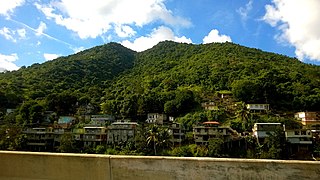
Aibonito is a small mountain town and municipality in Puerto Rico located in the Sierra de Cayey mountain range, north of Salinas; south of Barranquitas and Comerío; east of Coamo; and west of Cidra, and Cayey. Aibonito is spread over 8 barrios and Aibonito Pueblo. It is part of the San Juan-Caguas-Guaynabo Metropolitan Statistical Area.

Río Cañas is a barrio in the municipality of Las Marías, Puerto Rico. Its population in 2010 was 284.

Aibonito is a barrio in the municipality of San Sebastián, Puerto Rico. Its population in 2010 was 1,972.

Algarrobo is a barrio in the municipality of Aibonito, Puerto Rico. Its population in 2010 was 383.

Cuyón is a barrio in the municipality of Aibonito, Puerto Rico. Its population in 2010 was 977.

Pasto is a barrio in the municipality of Aibonito, Puerto Rico. Its population in 2010 was 4,184.

Plata is a barrio in the municipality of Aibonito, Puerto Rico. Its population in 2010 was 1,724.

Robles is a barrio in the municipality of Aibonito, Puerto Rico. Its population in 2010 was 3,863.

Llanos is a barrio in the municipality of Aibonito, Puerto Rico. Its population in 2010 was 6,840.

Guacio is a barrio in the municipality of San Sebastián, Puerto Rico. Its population in 2010 was 640.

Cialitos is a barrio in the municipality of Ciales, Puerto Rico. Its population in 2010 was 1,449.

Cordillera is a barrio in the municipality of Ciales, Puerto Rico. Its population in 2010 was 2,348.

Palomas is a barrio in the municipality of Comerío, Puerto Rico. Its population in 2010 was 4,719.

Cedrito is a barrio in the municipality of Comerío, Puerto Rico. Its population in 2010 was 1,191.

Asomante is a barrio in the municipality of Aibonito, Puerto Rico. Its population in 2010 was 2,966.

San Antonio is a barrio in the municipality of Quebradillas, Puerto Rico. Its population in 2010 was 5,164.

Daguao is a barrio in the municipality of Naguabo, Puerto Rico. Its population in 2010 was 2,273.

Hato Nuevo is a barrio in the municipality of Gurabo, Puerto Rico. Its population in 2010 was 9,345.

Botijas is a barrio in the municipality of Orocovis, Puerto Rico. Its population in 2010 was 3,720.





















